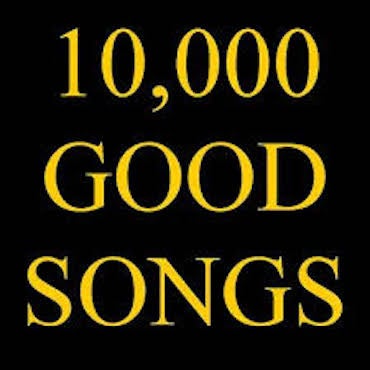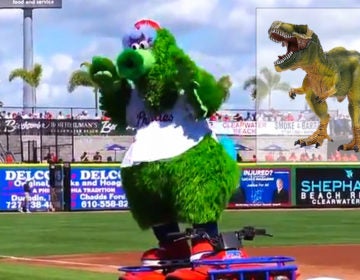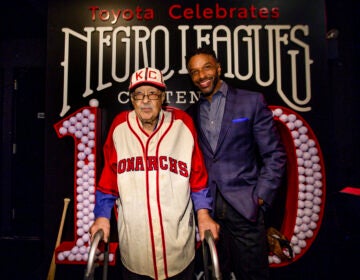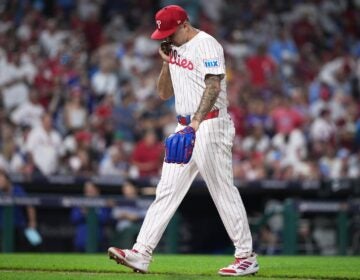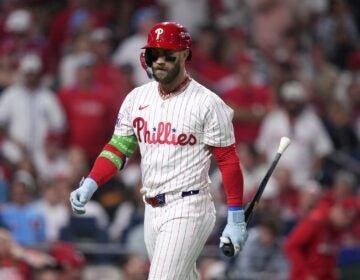150 years of high hopes: The tale of Philly’s first professional baseball season
150 years ago, Philadelphia entered its first team in a pro baseball league. It was a different game back then, but that team has surprising ties to today.
Listen 4:59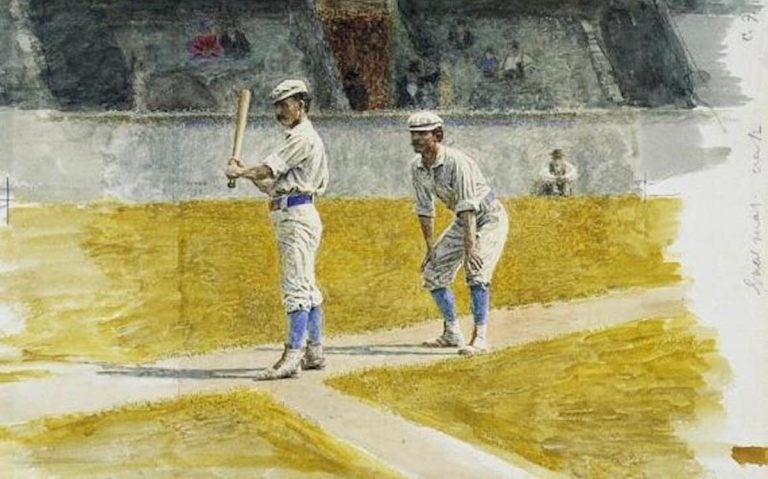
Famed Philadelphia artist Thomas Eakins painted Philadelphia Athletics players practicing in 1875.
Thrown games. Rowdy fans. A “great” fire. And a team called the Fort Wayne Kekiongas.
Baseball in 2021 may have more polish. But baseball in 1871 sounded just as interesting — maybe moreso.
That was the year the Athletic Base Ball Club of Philadelphia — known as the Philadelphia Athletics — became the first team to represent the city in a professional baseball league.
For the next 150 years, entertainment fads would come and go. But professional baseball would endure.
As the Philadelphia Phillies begin another season Thursday afternoon, we’re taking a trip back in time to when it all began.
Baseball, hallelujah!
The members of today’s Philadelphia Phillies almost certainly run faster, throw harder, and hit further than the members of the original Athletic Base Ball Club of Philadelphia.
But they probably don’t sing as well.
Back in 1859, members of a local men’s singing group — a Handel and Haydn Society — decided they needed more exercise.
So, like many young men working office jobs, they decided to form a new club focused on the hot, new sport of the mid-19th century: baseball.
“You need to take your exercise somehow,” explained Richard Hersberger, an author and historian of early baseball, “so you form a baseball club to get together twice a week, you know, two afternoons a week and play ball.”
The Athletic Base Ball Club of Philadelphia was an amateur endeavor in its nascent years. In true Philadelphia fashion, however, it quickly got out of hand.
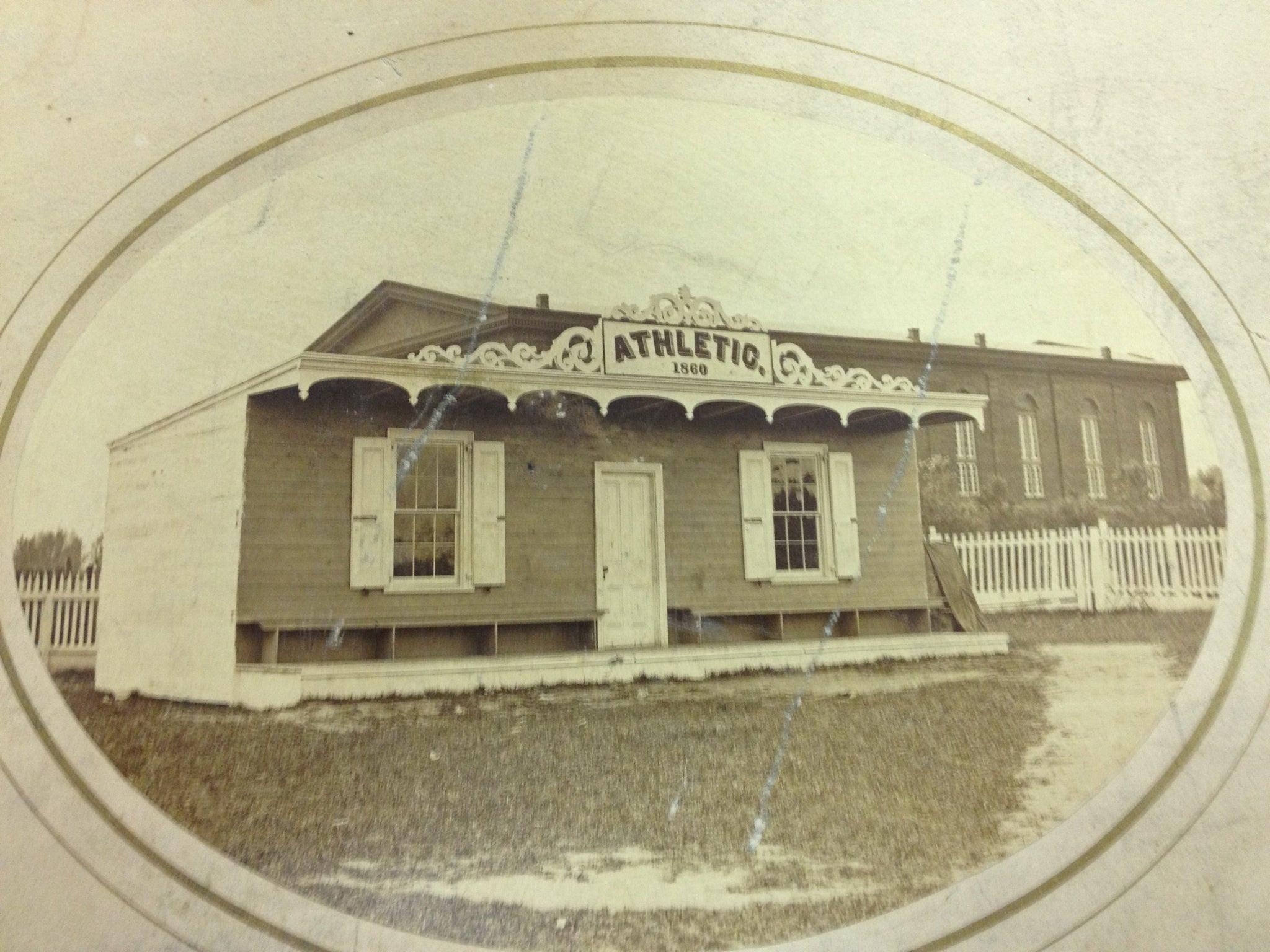
“Once teams became affiliated with the community, the community wanted to win,” said Jerrold Casway, a Philadelphia native who has written extensively on early baseball history.
Many amateur clubs started to pay players “under the table,” Casway explained. Perhaps the club president would find a plush job for some hotshot player from out of town. Maybe the man would suddenly find his moving expenses covered.
Star infielder Alfred Reach relocated from Brooklyn to Philadelphia in 1865 and, rather miraculously, found himself operating a cigar store financed by the president of the Athletic Base Ball Clubs.
The tension between amateurism and professionalism resulted in a schism in 1871.
On March 16, 1871, a group of amateur teams formed their own association, according to Hershberger.
The next day, a group of nine other clubs formed the nine-team National Association of Professional Base Ball Clubs. The league — which would morph into what we now call the National League — was the first, above-board, all-professional baseball league in the world.
The competition included teams like the Fort Wayne Kekiongas and the Troy Haymakers — names and cities that beckon to a distant past. But there were also traces of baseball’s present. The Boston Red Stockings and the Chicago White Stockings finished second and third respectively that year.
Those Red Stockings would evolve into the Boston Braves — which became the Milwaukee Braves and today’s Atlanta Braves. The White Stockings would eventually rebrand themselves as the Chicago Cubs.
The original Philly fans
The league was loose by modern standards, but it pioneered concepts that have become part of our modern sporting landscape.
Though there wasn’t a set schedule, said Hershberger, the teams did coordinate roughly when they would play one another. That was a departure from the barnstorming model, where clubs would rove around the country seeking competition.
The National Association of Professional Base Ball Clubs also came up with the concept of a league champion.
Prior to that season, there was a challenger system — much like what we have today in boxing. A team could claim they were the champs until another team defeated them — upon which their challenger would assume the title.
The National Association of Professional Base Ball Clubs decided to create a system where teams would play each other throughout the course of a season and the champion would be the team with the best record.
“They invented that idea,” said Hersberger. “That was new.”
Some aspects of the game did not last.
Back in 1871, pitchers threw underhanded and the mound was only 45 feet from home plate — about 15 feet closer than it is today.
At Jefferson Street Grounds, where the Athletics played, the center field wall was an astonishing 500 feet from home plate, according to Matt Albertson, who helped the site receive an historical marker.
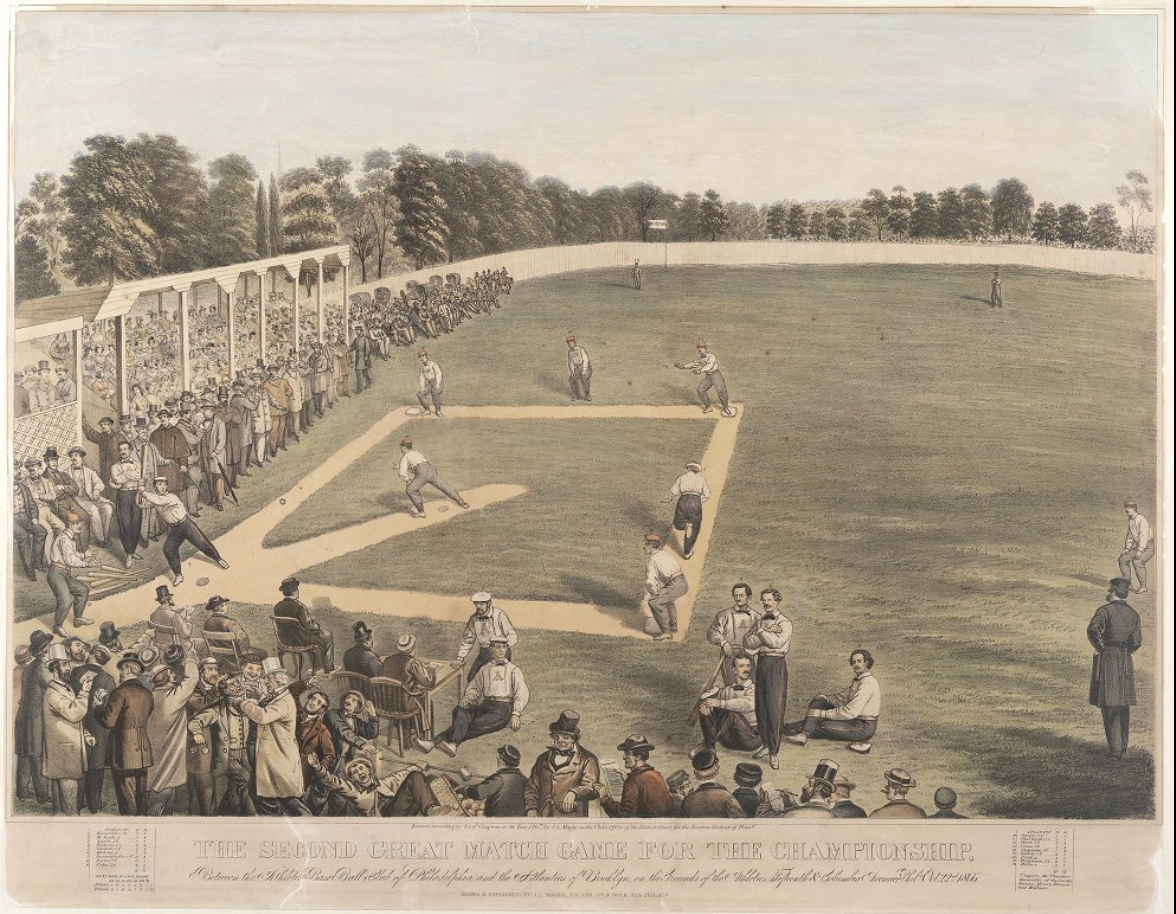
The field at 26th and Jefferson Streets was a prominent ball field before the Athletics arrived. In an era where the sport was starkly segregated, it hosted the first interracial baseball game in 1869 — the all-white Olympic club versus the all-Black Pythians, led by civil rights leader Octavius Catto.
Today, the lot sits in North Philadelphia’s densely populated Brewerytown neighborhood. At the time, though, it was on the fringe of the city. That placement, Albertson said, was intentional.
“They don’t play baseball in the city center,” said Albertson. “There is the sense that baseball shouldn’t be played where all the people are.”
That may be because, even back then, the Philadelphia fan experience tended toward rowdiness.
To wit, an 1866 artist’s sketch of an Athletics game shows one fan strangling a thwarted pickpocket while men who appear to be gamblers confer nearby. Another contemporary account tells of an umpire so thoroughly berated by the Philadelphia fans, Albertson said, that the ump refused to work another game in the city.
The players on the 1871 Philadelphia Athletics also had their quirks.
Shortstop John Radcliffe was a notorious “hippodromer,” said Albertson — meaning he would help throw games for gamblers. Ned Cuthbert was known as a “revolver,” a player who would switch teams regularly and even renege on a previously signed contract.
The legend, according to Albertson, is that Cuthbert actually signed with the Chicago White Stockings, but switched to Philadelphia when his wife found the Chicago housing stock wanting.
Wes Fisler was the son of a former Camden mayor. And John “Count” Sensenderfer worked in the sports department at a local newspaper, according to Richard Hershberger.
It’s unclear how Count Sensenderfer got his nickname, though there’s speculation it had to do with either his aristocratic aura or his womanizing.
Who are the champions, my friend?
Backstories aside, the members of the 1871 Athletics had game.
Slugger Levi Meyerle and pitcher Dick McBride helped the team soar toward the top of the standings.
Going into the final stretch of the season, according to baseball historians John Thorn and Alan Cohen, the Athletics needed to hold off Boston and Chicago for the crown. A final game against Chicago in October would decide whether the Athletics won the title outright — or whether they’d wind up in a three-way tie with their closest rivals.
Chicago was at a distinct disadvantage. They had to play in borrowed uniforms because the team had lost all of its possessions in what was known as the Great Chicago Fire. Forced onto a long, dreary road trip, the White Stockings arrived bedraggled.
So, too, did the Athletics, who had just eight available players because of injury.
Luckily, the team’s treasurer, Nate Berkenstock, was a former player and available to swap in. He made a couple of catches to help secure the win — including the final out.
This win did not, however, set off a raucous celebration or parade.
Only about 500 fans attended the clincher — which was about a tenth of what teams could draw on the best days.
That’s partly because there was still confusion about how the championship would be decided that year.
There were several points of contention, including how to count some of the early-season games played by the Fort Wayne Kekiongas — who had used a player since declared ineligible.
“You had to have a meeting to figure this out and tensions run high at that point,” said Hersherberger.
After some back-room bickering, the teams declared the Athletics the first ever champions of the first ever professional baseball league.
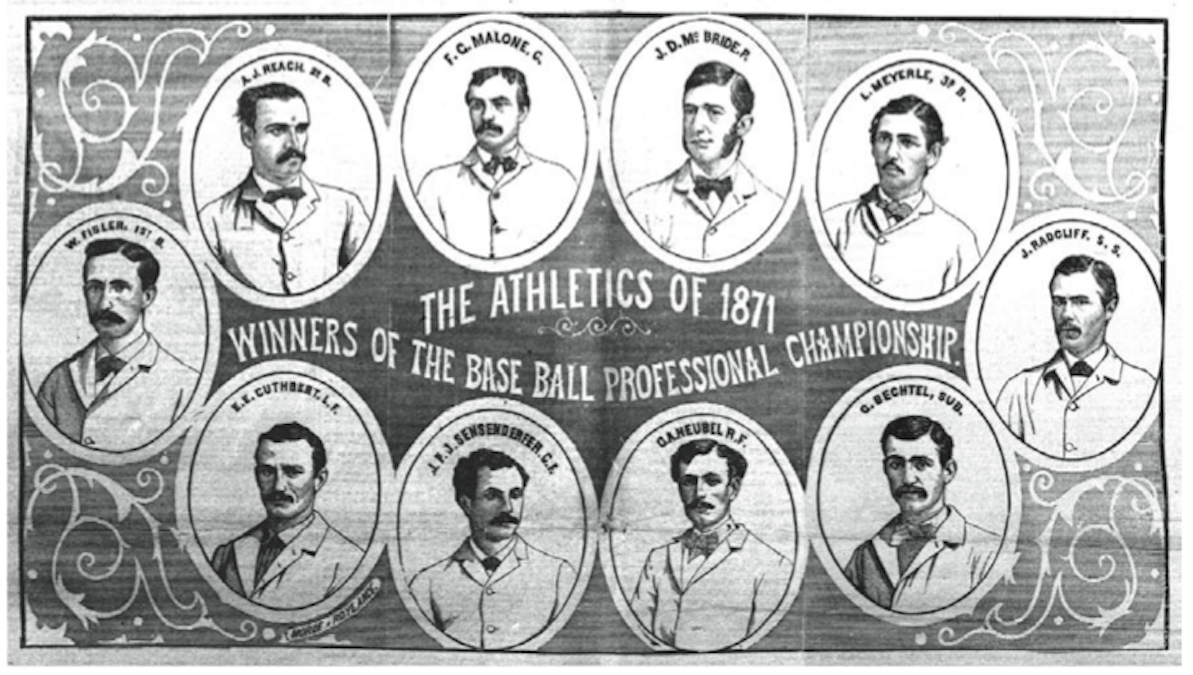
Reaching to the present
Despite their rousing start, the Athletics only lasted five more seasons as a club.
Still, they left their mark on the modern game.
Two subsequent clubs named themselves the “Athletics,” harkening back to the glory of Philadelphia’s first pro team. The most prominent was the Philadelphia Athletics of the American League, which formed in 1901, won five championships under legendary manager and owner Connie Mack, and finally left the city in 1954.
That club still exists today as the Oakland A’s.
The original Philadelphia A’s from 1871 have another key connection to the present. Their second baseman, Al Reach, went on to become a sporting goods magnate. After retiring from baseball, he helped found a new baseball club called the Philadelphia Quakers.
You might know them today as the Philadelphia Phillies.

Get daily updates from WHYY News!
WHYY is your source for fact-based, in-depth journalism and information. As a nonprofit organization, we rely on financial support from readers like you. Please give today.

